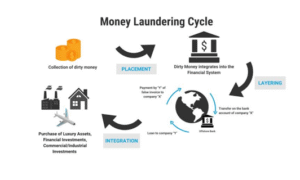
Why in News?
-
The Finance Minister reported in the Rajya Sabha that:
-
5,892 cases have been taken up by the Enforcement Directorate (ED) under the Prevention of Money Laundering Act (PMLA) 2002 since 2015.
-
Out of these cases, only 15 convictions have been secured by special courts.
-
-
This raises serious concerns about:
-
The increasing number of money laundering cases
-
The low conviction rate
-
The effectiveness of the law in tackling such financial crimes
-
What is Money Laundering?
-
Definition (Section 3 of PMLA):
-
Money laundering refers to any process or activity connected with the proceeds of crime where such proceeds are concealed, possessed, acquired, or used and projected as untainted property.
-
-
It involves:
-
Disguising illegally obtained money
-
Making it appear legitimate or legal
-
Origin of the Term “Laundromat”
-
The term comes from:
-
The use of laundromats (self-service washing facilities) by organised crime syndicates in the United States as fronts to hide illegal money
-
-
Today, it broadly represents financial vehicles such as:
-
Shell companies or fake businesses used to:
-
Launder proceeds of crime
-
Hide ownership of assets
-
Evade taxes and currency restrictions
-
Transfer money offshore
-
-
Stages of Money Laundering
Placement
-
The initial stage where illicit money is introduced into the financial system
-
Techniques include:
-
Smurfing: breaking large amounts of cash into smaller deposits to avoid detection
-
Layering
-
Funds are moved across accounts or jurisdictions to obscure their origin
-
Involves:
-
Multiple complex financial transactions
-
Investments and transfers to create confusion
-
Integration
-
The final stage where laundered money re-enters the economy appearing legitimate
-
It is invested in:
-
Real estate
-
Businesses
-
Luxury goods
-
Other assets
-
Impact of Money Laundering
Economic Effects
-
Expands money supply and distorts financial markets
-
Affects monetary stability and inflation
-
Impacts trade by enabling:
-
Unfair competition
-
Illegal funding
-
National Security Risks
-
Linked to:
-
Terror financing
-
Organised crime
-
-
Undermines:
-
The sovereignty and integrity of the nation (Supreme Court, P. Chidambaram vs ED, 2019)
-
International Reputation
-
Weak enforcement affects:
-
India’s credibility in global financial systems
-
-
Can invite:
-
Scrutiny from global bodies like the Financial Action Task Force (FATF)
-
Legal Framework in India – Prevention of Money Laundering Act (PMLA), 2002
Purpose
-
To prevent and control money laundering
-
To confiscate property derived from or involved in money laundering
Key Features
-
Burden of Proof: Lies on the accused to prove that the money is legitimate
-
Enforcement Case Information Report (ECIR): Considered equivalent to an FIR and sufficient to initiate proceedings (Vir Bhadra Singh vs ED, 2017)
-
Scheduled Offences: The act of money laundering is dependent on the existence of a “scheduled offence” (predicate offence)
Judicial Interpretations
Vir Bhadra Singh vs ED (2017)
-
Held that no FIR is required to initiate proceedings
-
ECIR is sufficient
-
Chidambaram vs ED (2019)
-
Emphasised that:
-
Concealing illegal sources of money affects sovereignty and national integrity
-
Vijay Madanlal Chaudhury vs Union of India (2022)
-
For initiating prosecution under Section 3:
-
A registered scheduled offence is required
-
-
However, under Section 5:
-
Property attachment can be done without a pre-registered criminal case
-
This has led to misuse by authorities
-
Issues with Implementation of PMLA
Low Conviction Rate
-
Only 15 convictions out of nearly 5,900 cases since 2015
Increasing Cases
-
The rising number of money laundering cases indicates:
-
Gaps in enforcement and deterrence
-
Alleged Misuse
-
Cases of politically motivated misuse have been highlighted by the Supreme Court
Complex Process
-
Investigation and prosecution are often:
-
Slow
-
Involve extensive financial tracking across jurisdictions
-
International Measures – FATF and Global Standards
Financial Action Task Force (FATF)
-
An intergovernmental body that:
-
-
Sets global standards for anti-money laundering (AML) and counter-terrorist financing (CFT)
-
-
Recommends:
-
-
Strict regulations
-
Reporting mechanisms
-
International cooperation
-
-
India is:
-
-
A member of FATF
-
Expected to comply with its guidelines
-
Double Taxation Avoidance Agreement (DTAA) and Its Role
What It Is?
-
A treaty signed between two or more countries to:
-
Avoid double taxation of the same income
-
-
India has signed DTAA with:
-
About 85 countries
-
How It Helps in Preventing Money Laundering
-
Facilitates:
-
Exchange of tax and financial information between participating countries
-
-
Helps:
-
Track suspicious cross-border transactions
-
Identify illegal fund transfers
-
-
Assists tax authorities in:
-
Identifying cases of tax evasion and related money laundering activities
-
Way Forward
Strengthen Enforcement Mechanisms
-
Modernise investigation tools
-
Use technology-driven financial tracking
Increase Conviction Rate
-
Improve coordination between:
-
ED, judiciary, and police
-
-
Ensure faster trials
Prevent Misuse
-
Ensure checks and balances
-
Stop politically motivated investigations
Global Cooperation
-
Enhance information-sharing under DTAA
-
Collaborate closely with:
-
FATF
-
Other nations
-
Public Awareness
-
Educate:
-
Businesses
-
Financial institutions
-
-
On compliance and reporting of suspicious transactions
Conclusion
-
Money laundering remains a serious economic and national security challenge in India
-
Despite stringent laws like PMLA and global agreements such as DTAA:
-
Rising cases and low convictions indicate the need for:
-
Stronger enforcement
-
Judicial reforms
-
International cooperation
-
-
-
Tackling money laundering is crucial:
-
Not only for financial stability
-
But also to curb its linkages with terror funding and organised crime
-




